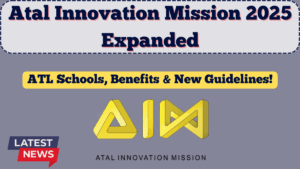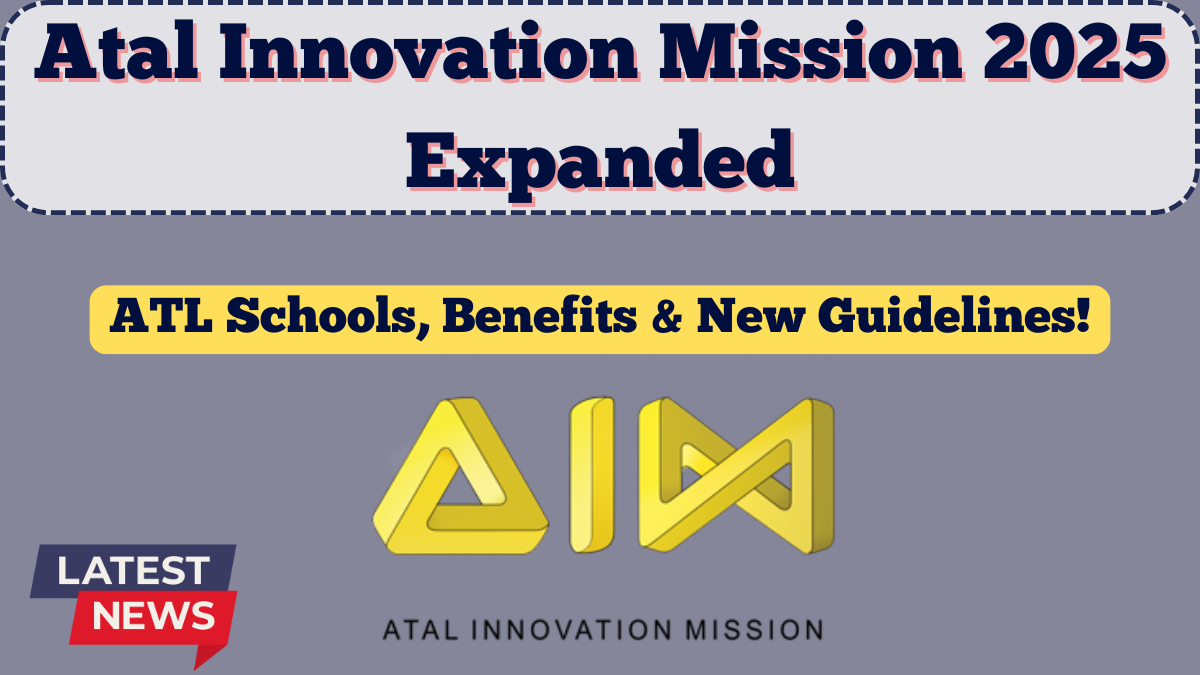Atal Innovation Mission 2025 update has been officially released by NITI Aayog, marking a major expansion in India’s flagship innovation and entrepreneurship program for school students. As part of the government’s push towards future-ready education, the number of Atal Tinkering Labs (ATLs) has now been increased across the country, empowering more schools with the tools, training, and technology to foster creative thinking and problem-solving.
The latest update includes new ATL school selections, upgraded equipment kits, revised mentoring programs, and integration with NEP 2020 goals. This expansion is designed to equip India’s next generation with 21st-century skills such as robotics, coding, AI, IoT, and design thinking. Thousands of students are already participating in real-time innovation projects, hackathons, and prototype competitions through these labs.

Key Highlights of the Atal Innovation Mission 2025
As per the Atal Innovation Mission 2025 update, the program is being scaled with significant reforms and nationwide impact. The following initiatives are now in effect:
-
Addition of 5,000 new ATL schools, taking the total count beyond 20,000 nationwide
-
Introduction of AI, Machine Learning, and 3D printing modules in ATL kits
-
Launch of the ATL School Innovation Challenge 2025 with rewards up to ₹10 lakhs
-
Establishment of Women-Led Innovation Cells to promote inclusivity in STEM
-
Mandatory teacher capacity building programs for effective ATL integration
These changes are aligned with the goal of creating a nation of job creators rather than job seekers.
List of Newly Selected ATL Schools
The updated list of ATL schools for 2025 includes institutions from urban, semi-urban, and rural areas across India. Special emphasis has been placed on:
-
Government and tribal schools in Jharkhand, Odisha, Assam, and Chhattisgarh
-
Minority and girls’ schools in Uttar Pradesh, Bihar, and Rajasthan
-
CBSE and state-board schools under PM SHRI and KVs in metro cities
Each selected school receives:
-
One-time grant of ₹20 lakhs (₹10 lakhs for lab setup, ₹10 lakhs for operational costs over 5 years)
-
A complete tinkering lab setup with toolkits for electronics, sensors, robotics, and DIY science
-
Access to mentor networks and webinars under AIM
This expansion ensures that innovation education reaches students from all socio-economic backgrounds.
Benefits of ATL and AIM for Students
The Atal Innovation Mission 2025 update strengthens India’s education-to-innovation pipeline through real-world learning experiences. Key student benefits include:
-
Hands-on exposure to emerging technologies and product development
-
Participation in national innovation competitions and exposure visits
-
Guidance from industry experts, researchers, and young entrepreneurs
-
Opportunity to create and pitch start-up ideas while still in school
-
Confidence building through prototype showcases and team collaboration
Students who perform exceptionally in ATL activities also gain eligibility for national-level innovation scholarships and mentorship programs by NITI Aayog.
New Guidelines for ATL Implementation in 2025
With the expansion, NITI Aayog has released a new set of operational guidelines that schools must follow:
-
All ATL schools must appoint a full-time ATL-in-charge (teacher or coordinator)
-
Each school is required to conduct at least one innovation exhibition or competition per term
-
Schools must upload monthly ATL activity reports via the AIM portal
-
Integration with subjects like Science, Computer Science, and Math is encouraged
-
Collaboration with local colleges, IITs, and industries is promoted through innovation partnerships
These guidelines ensure that the labs function not just as infrastructure but as innovation ecosystems.
FAQs
What is the Atal Innovation Mission 2025 update all about?
It is the official expansion and upgrade of the AIM program, introducing more ATL schools, advanced tools, and updated guidelines to foster student innovation.
How many new ATL schools have been added in 2025?
A total of 5,000 new ATL schools have been added, increasing the nationwide count to over 20,000 institutions.
What support do schools receive under AIM 2025?
Selected schools get ₹20 lakhs in funding, complete ATL kits, mentorship access, and ongoing capacity-building support.
Who can apply to become an ATL school in 2025?
CBSE, ICSE, and state-board schools across India can apply through the official AIM portal if they meet the eligibility and infrastructure criteria.
What are the student benefits under the updated AIM program?
Students gain hands-on exposure to emerging tech, participate in innovation contests, access mentor networks, and can apply for innovation scholarships.
Click here to know more.
